To make a long story short, I’m making the case a wide subway loop around Lake Union. To accomplish, all you need to do is build the Ballard Spur and the first part of the Metro 8 Subway, and then loop these stub lines together via Central Link’s Capitol Hill to University District segment and the planned Ballard to Downtown (via Interbay) line. The loop replaces the operation of the Ballard Spur and Metro 8 Subway alone, allowing the routes to flow into one another and facilitate diagonal movements such as Ballard to Capitol Hill. I’ll go into more detail below.
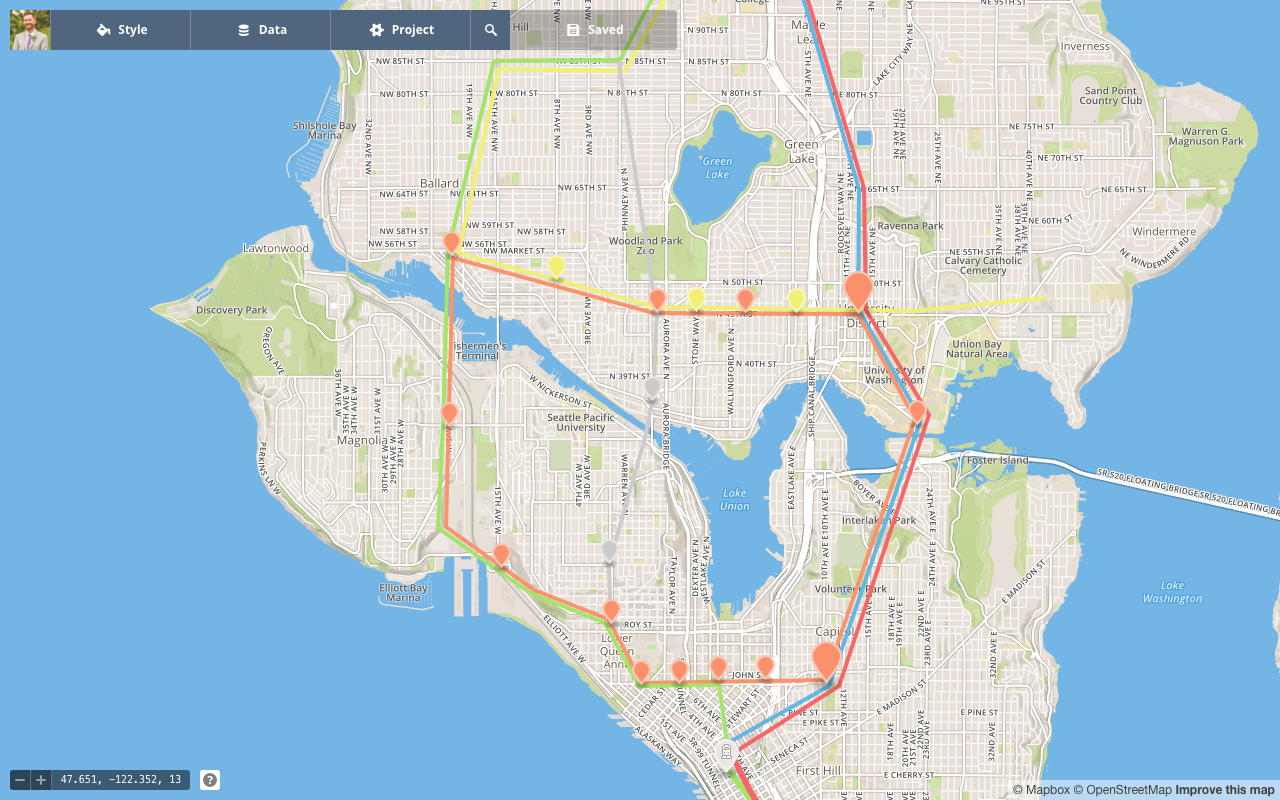
I also think that building both West Seattle light rail alignments, 3A (Delridge Way) and 3C (West Seattle Junction), together would best serve that portion Seattle, at least based on the Sound Transit study data. The two routes would share the expense of the Duwamish rail bridge and the trackage in SODO. I think both would pencil out better this way. Building Ballard to Downtown, the Ballard Spur, a starter line for the Metro 8 Subway and a split West Seattle light rail line is going to be expensive. Thus, this is also an argument for STcomplete, Seattle Subway’s idea of doubling the timeline to 30 years so that we have the money to pay for all our good ideas.
Predicting the Leanings of the Sound Transit Board
Sound Transit has less than a year before Sound Transit 3 (ST3) goes to the ballot. The Sound Transit Board must finalize their project list and decide on a time span for the next phase of buildout. Expanding the timeline means more money and more projects. At 15 years, Sound Transit would have funding capacity of $15 billion for investments. Adding years beyond the base fifteen expands the capacity exponentially due to Sound Transit’s bonding going off the books.
At 25 years, Sound Transit would have more than $30 billion to work with. A few Sound Transit Boardmembers have indicated a preference for 20 years or perhaps even 25 years in a transportation expansion package. That would expand the number of projects to serve the many light rail-hungry voters in the region. The following is a list based on the latest Sound Transit study:
North Spine – Lynnwood to Everett
- Cost: $3 to $5 billion
- Ridership: 42,000 to 58,000
- Travel time: 25 to 38 min, depending on option
South Spine – Kent to Tacoma Dome
- Cost: $3.5 to 3.7 billion
- Ridership: 49,000 to 69,000
- Travel time: 28 minutes
- Alignment: I-5
Ballard to Downtown
- Cost: $4.4 to 5.3 billion
- Ridership: 67,000 to 87,000
- Travel time: 19 min
- Alignment: Favoring a grade separated Interbay routing
New Downtown Seattle Transit Tunnel
- Cost: $2 billion
- Ridership: bumps Ballard line to 102,000 to 133,000
Ballard to Ballard High School Elevated Extension
- Cost: $350 million
- Ridership: 4,000 to 5,000
- Travel time: 2 minutes
West Seattle Junction to Downtown
- Cost: $1.8 billion
- Ridership: 39,000 to 50,000
- Time: 11 minutes
- Alignment: Favoring elevated light rail
West Seattle Junction to Burien
- Cost: $2.8 billion
- Ridership: 18,000 to 26,000
- Travel time: 22 minutes
Downtown to Delridge to White Center
- Cost: $2 billion
- Ridership: 34,000 to 40,000
- Travel time: 18 minutes
Ballard to University District Subway (Ballard Spur)
- Cost: $3 billion
- Ridership: 19,000 to 24,000
- Travel time: 7 minutes
Totem Lake to Issaquah
- Cost: $3.2 to 3.4 billion
- Ridership: 12,000 to 15,000
- Travel time: 31 minutes
Overlake to Downtown Redmond
- Cost: $1 to 1.1 billion
- Ridership: 8,000 to 10,000
- Travel time: 8 minutes
1. Spine Obsession
The Board’s obvious first priority is in building the Spine from Tacoma to Everett, and it would appear they might have $9 billion or more sunk into that endeavor. Part of the reason that number has climbed so high is Sound Transit is letting Snohomish County talk its way into working in a Paine Field dogleg that would cost about $2 billion more than a simple, direct I-5 route — and maybe $1 billion more than a SR-99 routing that is the most urban and transit-oriented development supportive option for the county.
2. Bowing to Booming Ballard
In Seattle, connecting Ballard to Downtown stands out, particularly with a new Downtown transit tunnel, which allows the whole project to draw a projected 102,000 to 133,000 riders for a capital investment of about $7 billion. In comparison, the Spine’s $9 billion is projected to add 91,000 to 127,000 riders. (Personally, I’m generally skeptical that suburban routes will meet estimated projections.) Ballard is a rock solid investment.
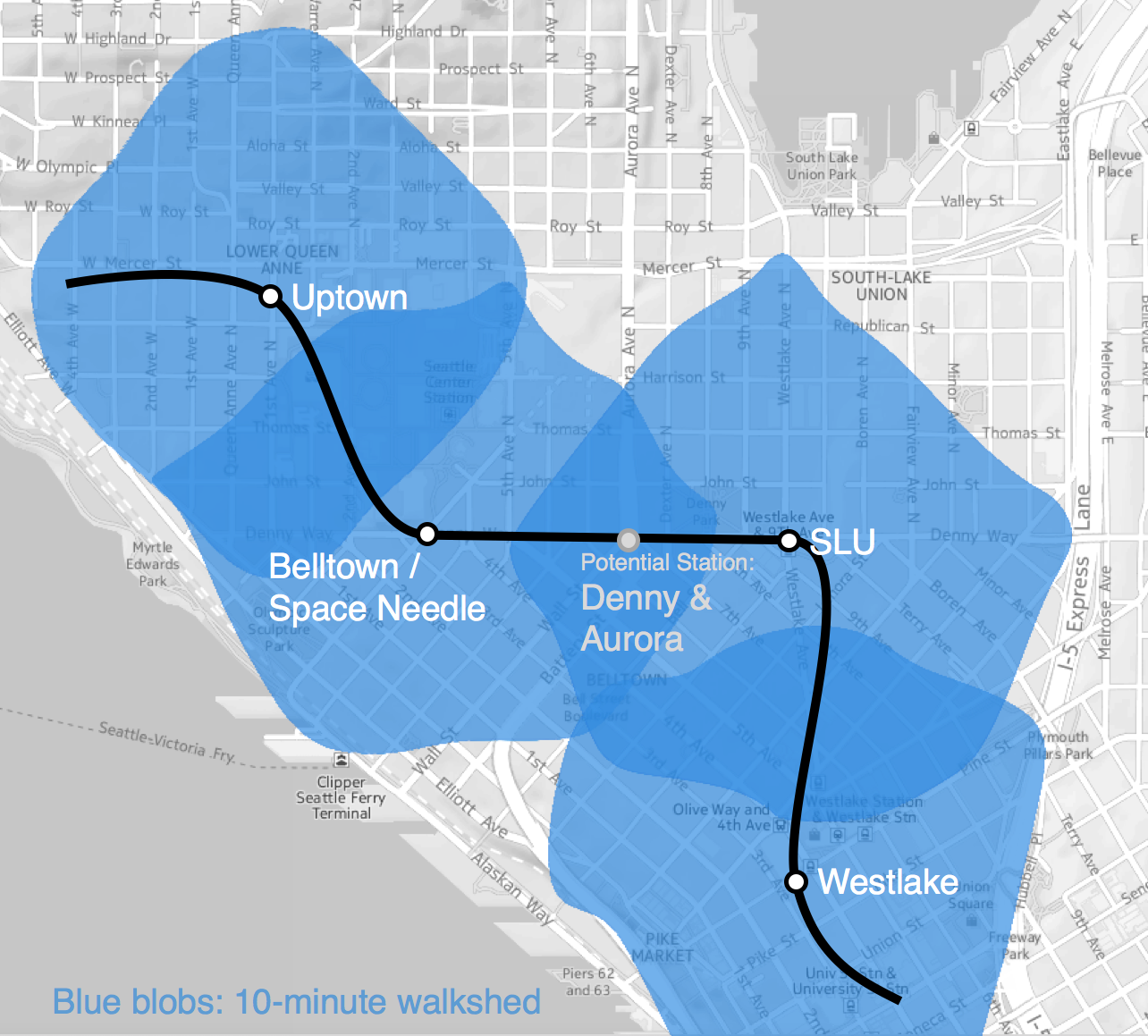
The latest work from Sound Transit shows a Ballard to Downtown light rail line that manages to completely avoid Belltown, veering toward South Lake Union instead. Anton Babadjanov, a write for The Urbanist, presented a nice alternative routing that manages to connect both Belltown and South Lake Union via the Ballard line.
Initially, I thought the the ideal solution to the Belltown/South Lake Union problem would actually be two subways; that being the Metro 8 Subway along Denny Way paired with the direct routing of the Ballard line through Belltown. Unfortunately, Sound Transit doesn’t appear to want to touch the Metro 8 Subway with a ten-foot pole. It might be up to Seattle alone to build that urban line. Anton’s routing could help Seattle jump start the lurching progress of planning Metro 8 Subway and cut its eventual cost down the road by getting three pricey underground stations built with the Ballard line (it also helps with a loopy idea I will get to later on).
3. The West Seattle Political Expediency Express
West Seattle seems to be the Board’s second priority, and most people expect the 3A option to West Seattle/Alaska Junction even though the Delridge Way (3C) routing projects to get almost as many riders and more effectively meet the Board’s own equity goals. Part of the momentum to 3A stems from what seems to be Sound Transit inflating their numbers. Their latest “Corridor Summary” has 3A inexplicably getting ridership of 39,000 to 50,000, despite projecting to have a population of just 21,300 in the West Seattle Junction corridor. As part of the same study, but at a more detailed level (page C-46), the report showed 3A getting a ridership of 23,000 to 29,000. Meanwhile, the Delridge option projects ridership in the 34,000 to 40,000 range in the same Corridor Summary (versus 19,000 to 22,000 in the more detailed study), despite a slightly larger population in the corridor.
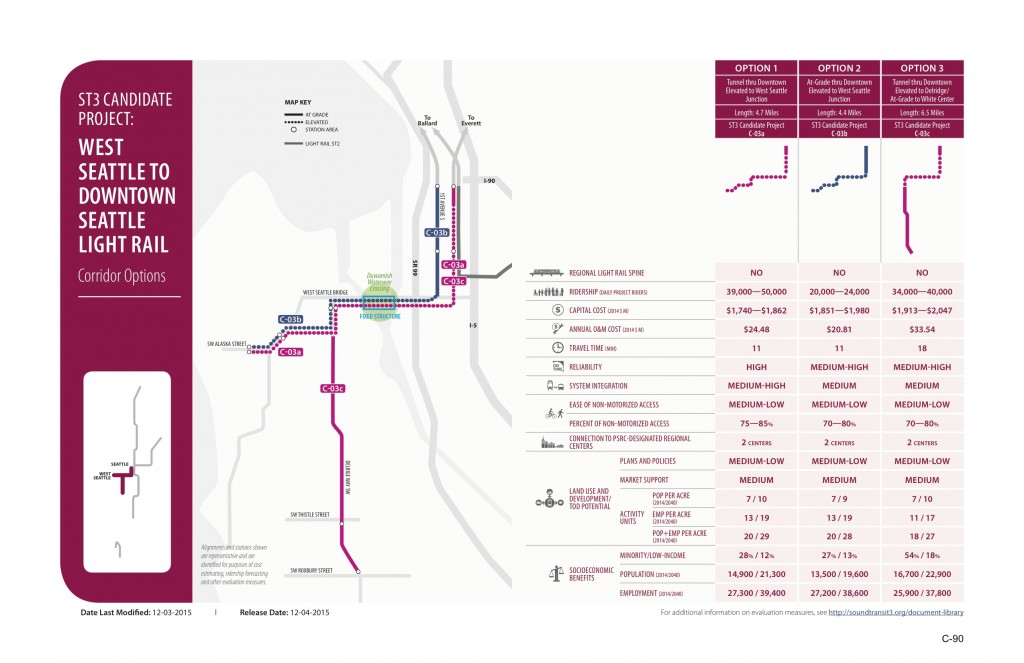
It’s surprising that the Delridge Way alignment performed so well in the Corridor Summary since Sound Transit included only three stops in Delridge, and none for a 3-mile stretch from about Spokane Street to Thistle Street. Most of Delridge Way isn’t particularly dense, but it doesn’t cost much to add an at grade station. Adding a station near the Delridge Library and another at Orchard Street would rectify this oversight and make the Delridge line even more useful. The Delridge Way line would serve a substantial minority population who make up 54% of residents. Yet, the elevated West Seattle Junction line would only serve a resident minority population of 28%. Choosing an alignment solely to West Seattle Junction could open the Board up to severe criticism over the lack of equity and run counter to stated agency social goals.
Maybe we don’t have to choose. The new rail bridge to cross the Duwamish is one of the most expensive elements of reaching West Seattle. If we can engineer a rail junction at Delridge Way, both lines could share the new bridge. Approximately $1.8 billion for SODO to Alaska Junction and $2 billion for SODO to White Center via Delridge Way could potentially become $3 billion or less for both. The split line would offer much higher combined ridership than one line alone. And Delridge Way provides a more direct route to Burien. That should translate into some major savings off of the lofty $2.8 billion price tag of to reach Burien Transit Center from Alaska Junction. That figure could be cut in half, if not more so, since White Center (the last stop of the Delridge Way line) is midway between Alaska Junction and Burien Transit Center.
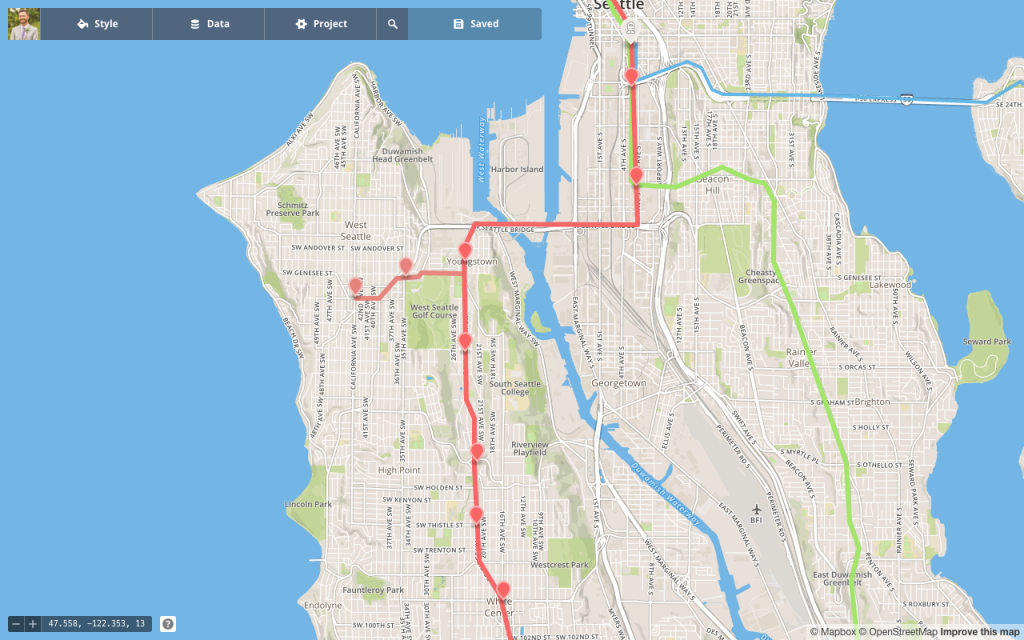
One downside is not directly reaching the Morgan Junction or High Point, but a light rail extension could be added later, while in the meantime we would serve those neighborhoods with restructured feeder buses from West Seattle Junction or Delridge Way.
4. Burying the Spur?
Sound Transit has studied light rail that would connect Ballard to the University District (the Ballard Spur). But the study tacked on an operations and maintenance facility to the project, perhaps inflating its cost relative to others. This suggests the Board isn’t too interested in building the Ballard Spur this time around. Still, it draws 19,000 to 24,000 riders for $3 billion and serves Fremont and Wallingford with light rail where other projects do not. It seems bizarre that Sound Transit maintains that a 4.7-mile West Seattle Junction line would see more than double the ridership of the Ballard Spur’s, despite the Ballard Spur having more than double the population. Further, West Seattle Junction costing $1.8 billion to the Ballard Spur’s $3 billion is also a headscratcher.
I suspect the spur’s lackluster ridership numbers relative to other lines hint at weakness in their ridership projection model. It seems doubtful that Sound Transit projections fully account for growth near stations affecting future ridership and the extent pedestrian-friendly environments encourage people to walk to stops whereas hellish motor-nightmares encourage people to seek other modes.
Beyond the Spine: Prioritize Urban Centers, Hubs, and Villages
Seattle Subway’s guiding principle is that every neighborhood deserves high-quality light rail. More and more, I’m seeing the wisdom in that. We need to distribute growth throughout the city so that it is equitable and spreads the benefits of vibrant urban commercial districts. The question is how to prioritize which neighborhoods should be served first. The densest and fastest growing neighborhoods make the most sense. Seattle projects that 80% of the city’s job and housing growth in the next 20 years will be in urban centers, hubs, and villages, which I will collectively refer to as “urban nodes”.
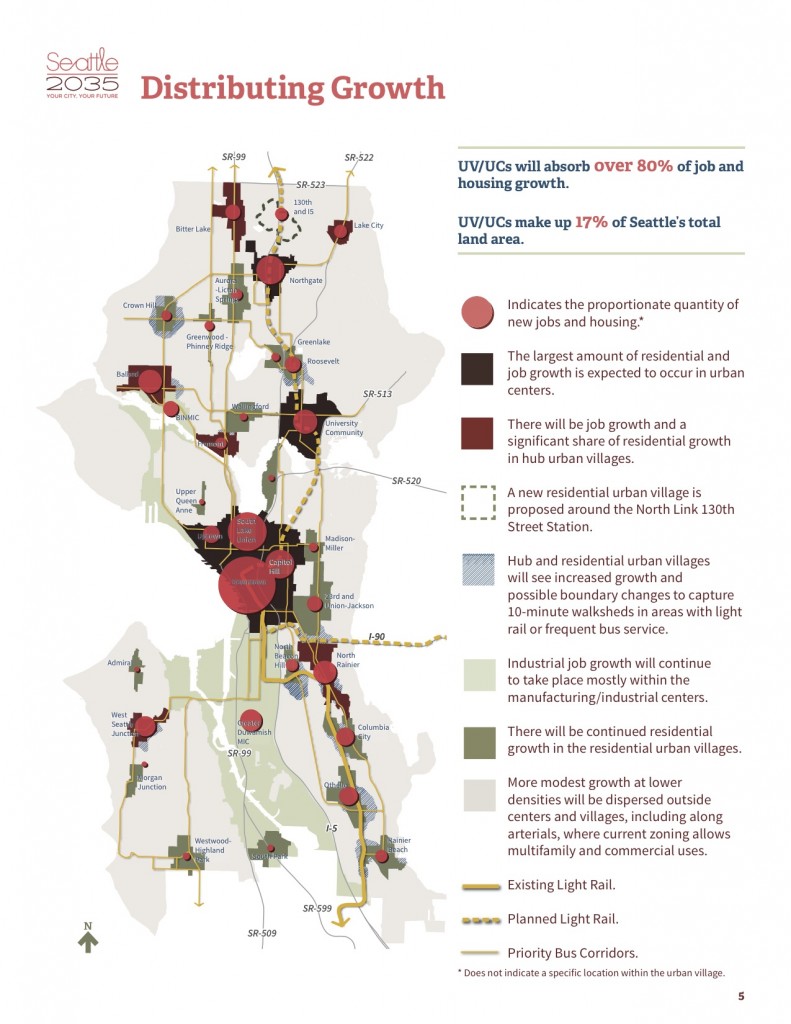
Urban nodes are already denser than average Seattle neighborhoods and growth will make them more so. Thus, urban nodes seem prime candidates for light rail stations. Ideally, we would connect every urban node in ST3. This would also help the ballot measure appeal to a wide spectrum of the population. The question is whether even $30 billion would be sufficient to finance that much light rail mileage.
Who Gets Left Out?
The urban nodes of West Seattle Junction, Uptown, and Ballard look to make out splendidly in ST3, and Anton’s routing suggestion allows both Belltown and South Lake Union to get in on the fun. Capitol Hill, University District, Roosevelt, and Northgate all will be served once the ST2 investments in the Central Link go live. That covers many but not all of Seattle’s designated urban nodes. Notably missing are a myriad of urban nodes like Lake City, Bitter Lake, Upper Queen Anne, Central District, Fremont, Admiral District, First Hill, and many others. The City’s draft comprehensive plan calls for adding an urban village in the 130th Street area near Jackson Park. (Some, The Urbanist included, want to go farther and have pushed the City to add urban villages in more places, such as Wedgwood, Magnolia, Madison Park and Sand Point.)
Some of the omissions can be explained by geography. Lake City is far to the northeast and Bitter Lake is far to the northwest. The Admiral District is inconveniently located toward the tip of the peninsula in West Seattle. South Park fits neatly into neither the Fauntleroy nor Delridge corridor. Others look good on a map, but topography provides a challenge. Upper Queen Anne would require a underground station hundreds of feet deep, greatly adding to the cost. First Hill didn’t get a Central Link station because Sound Transit said it was physically impossible due to soil conditions.
Some neighborhoods likely won’t get light rail because they would too closely duplicate spine service, such as Eastlake and Green Lake. Central District could be served by the full Metro 8 Subway, but that subway hasn’t even been studied by Sound Transit let alone strongly considered. Meanwhile, the Ballard Spur might replicate the Ballard to Downtown line in some people’s eyes, but it does bring light rail service to Fremont and Wallingford.
Lake Union Loop
In a dream scenario fully exploiting STcomplete, Seattle would build Ballard to Downtown via Interbay, the Ballard Spur, and at least the first part of the Metro 8 Subway. With the about-to-open University Link extension, we’d have the lines to run a big loop around Lake Union to serve the urban nodes of Ballard, Lower Queen Anne, Belltown, SLU, Capitol Hill, University District, Wallingford, and Upper Fremont in a continuous circuit. Not serving the central business District (CBD) would be unorthodox, but, as South Lake Union develops as a job center rivaling the CBD, it could make more and more sense. To me, it just seems like a shortcut to more frequent service and one-seat rides throughout this dense and quickly growing part of Seattle.
A Lake Union Loop seems really far-fetched at first but it might not be so outlandish. The Ballard to Downtown line seems to be Sound Transit highest priority within Seattle. From Anton’s suggested South Lake Union station, it’s just a 3/4-mile extension to reach Capitol Hill Station, thereby alleviating one of the most tediously slow bus routes in Seattle, the Route 8. This is the only section of the Route 8 that the loop would absolutely need (extending it to the Central District would be nice, eventually). You would also need the Ballard Spur, but justifying its $2 to 3 billion cost might be easier if it offers more one-seat rides and better service to a wider swath of Seattle via the loop.
More Ambitious Loop With Lower Fremont, Queen Anne
We also have the option of tightening the loop by adding another line through Lower Fremont and Queen Anne. Unlike the latest Seattle Subway map, I’d run this line as an extension of the Metro 8 Subway rather than having the Metro 8 Subway head south to Tacoma in a U-shaped fashion. (You can view my map illustrating that idea here.)
The tighter loop would branch off from the spur in Upper Fremont and head south picking up Lower Fremont and South Pacific University before reuniting with the tweaked Ballard to Downtown line in Queen Anne. This would be a 2-mile section to connect 45th Street and Linden Avenue (where I have the Upper Fremont station straddling Aurora Avenue and Fremont Avenue) to Queen Anne Avenue and Galer Street. Two miles of twin bore tunnel and two more underground stations could cost upwards of $2 billion. Since the Ballard to Downtown and West Seattle to Downtown lines seem to be first on the pecking order, it may be awhile before Sound Transit has the funds to pay for these urban routes on the loop.
The Upper Queen Anne station would be expensive since Sound Transit has indicated it would have to be a particularly deep station. However, once you commit to that, it could still be incorporated into the Ballard to Downtown line without sacrificing much in terms of directness. This get Queen Anne light rail service much sooner and prepares the system for the 2-mile tunnel to branch off to Upper Fremont closing the loop.
Challenges
As always with high-quality rail, cost is a clear concern. The tweaks I’ve outlined to the Ballard to Downtown line could push it to the high end of cost estimates ($5 billion) and perhaps beyond with the new Downtown light rail tunnel (projected at $2 billion). However, piggybacking so much on this high priority line not only lays the foundation for a potential loop but also makes for a dynamic line connecting Interbay, Queen Anne, Uptown, Belltown, and South Lake Union, hopefully without sacrificing too much speed.
To close the loop, we are talking maybe $4 billion in addition to the modified Ballard to Downtown line, which projects to cost $7 billion with a new Downtown transit tunnel. We should also plan at least $3 billion for my West Seattle light rail idea. That’s $14 billion in Seattle light rail projects plus $9 billion for the Spine, $1 billion to reach downtown Redmond, $1 billion to reach Burien, perhaps even $3.3 billion to add a dubious Totem Lake to Issaquah line. It’s adding up, but we are still under $30 billion.
Even the the 3/4-mile segment to link South Lake Union to Capitol Hill station might push a $1 billion with the tunneling work and additional station. Running this as a continuous loop would require engineering intersections where they don’t exist on the Central Link alignment. We could plan intersections right into stations in Ballard and South Lake Union if we decide to go ahead with the loop. I think building the three-quarters of the subway to connect the new South Lake Union station in the Ballard line to Capitol Hill is a no-brainer no matter what. Sound Transit might try to get Seattle to foot some of the bill and this corridor is so important I wouldn’t rule it out.
Some lines could be more important to ST3’s electoral success than the Ballard Spur. Extending the Ballard line to Lake City would serve a large population of North Seattleites, picking up Crown Hill, Greenwood, and Licton Springs. That’s a promising project too. With so many intriguing projects, STcomplete is a must. I hope we see at least a 25-year timespan for the system expansion.
Doug Trumm is publisher of The Urbanist. An Urbanist writer since 2015, he dreams of pedestrianizing streets, blanketing the city in bus lanes, and unleashing a mass timber building spree to end the affordable housing shortage and avert our coming climate catastrophe. He graduated from the Evans School of Public Policy and Governance at the University of Washington in 2019. He lives in East Fremont and loves to explore the city on his bike.


